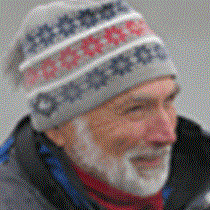Morning sun illuminated the reddish peninsula at the entrance of the bay. This conspicuous site can be clearly seen by anyone cruising along in Chatham Strait. The bluff is made up of ultramafic rock that has been brought to the surface during the tectonic subduction of a terrane. Because of high amounts of toxic nickel and chromium, most plants can’t grow here. Rain blanketed our ship as we entered this narrow fjord and gazed upon its magnificent waterfalls and a large meadow at the end. Once back in Chatham Strait and on our way north, we picked up Dr. Andy Szabo from the Alaska Whale Foundation. We towed his small boat while he explained the lives of humpback whales, their feeding behavior, and the almost unbelievable behavior of how certain groups work together to corral herring in a net of bubbles.
Around lunch time our ship’s officers and crew anchored in the far reaches of Takatz Bay, a deep incision into Baranof Island. The rain stopped as we looked upon magnificent peaks of granite draped with white and blue glacial ice. Yellow bobbing kayaks awaited eager paddlers. At this high tide kayakers were able to paddle up into the river’s current, drift aimlessly while mesmerized by the verdant wall of conifers at the water’s edge, or count the heads of dead salmon that had their brains bitten out by hungry bears. This bruin delicacy is a high-protein chow that they selectively choose along with the bellies hopefully filled with salmon eggs. A bald eagle caught a salmon in front of many kayakers, carried it to the beach, and ate it in front of about 15 northwestern crows cawing loudly and hopping around staring at the untouchable feast. Inflatable boat tours cruised along the shoreline watching spotted sandpipers, harlequin ducks and numerous gulls. Several groups saw river otters, and even got close enough to take a photograph for today’s daily expedition report.
A few adventurous hikers dove into the undergrowth, slogged through deep mud, and persevered until they ended their journey staring at a most pristine lake. It had been hidden by steep hillsides of hemlock, spruce, and Alaska yellow cedar and seemed so peacefully serene that we found ourselves quietly just listening to a distant waterfall and birds in the distance. The silence seemed almost delicious.
During cocktail hour we encountered surface-feeding humpbacks. First the water would look almost granular from krill forced to the surface, and then a massive mouth appeared with the pink palate on one side and the lower jaw on the other, rapidly expanding its ventral pleats as they swelled, balloon-like with seawater and krill. The forward momentum slowed, the mouth closed, and they sank below the surface. Over and over we watched this spectacle with all of us waiting quietly for the next humongous lunge. As if this wasn’t enough to watch, a strikingly black-and-white patterned group of Dall’s porpoises entered the scene. They rapidly shot forward, getting a bit of extra speed off the feeding humpbacks. The ship slowly turned away from the humpbacks and after a few hundred yards speeded up and picked up the porpoises that began to ride our bow wave and stern wake. Our guests were flipping out over this totally unexpected change of high-level entertainment. It was a remarkable way to end the day.









